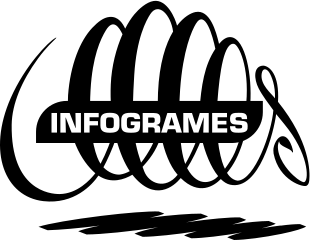Difference between revisions of "Atari, SA"
From Sega Retro
| Line 39: | Line 39: | ||
==Softography== | ==Softography== | ||
| − | :''Note: this list only contains games which Infogrames Entertainment were involved in. For subsidiaries, see the [[Accolade]], [[Beam Software]], [[Gremlin | + | :''Note: this list only contains games which Infogrames Entertainment were involved in. For subsidiaries, see the [[Accolade]], [[Beam Software]], [[Gremlin Interactive]], [[GT Interactive Software]], [[Hasbro Interactive]] and [[Ocean Software]] pages. |
{{CompanyHistoryAll|Infogrames}} | {{CompanyHistoryAll|Infogrames}} | ||
Revision as of 02:43, 21 February 2022

| ||
| Atari, SA | ||
|---|---|---|
| Founded: 1983-06 | ||
| Defunct: 2009-05-29 | ||
| T-series code: T-151 | ||
| Merged into: Atari SA | ||
Headquarters:
|
This teeny-tiny article needs some work. You can help us by expanding it.
Infogrames Entertainment, SA (IESA), currently Atari, SA, was a video game developer and publisher. It now stands as a holding company.
Infogrames was established as a video game developer in France in 1983, producing games for various home computers in the country for much of the decade. While there had been minor successes for the company during its first ten years in business, it was the 1992 release of 3D survival horror game Alone in the Dark which brought Infogrames to the world stage.
In 1996 the company chose to adopt a policy of growth through acquisition, with the aim of becoming the largest interactive entertainment publisher in the world. To achieve this, Infogrames would spend $500 million USD over the next seven years acquiring studios to build its empire:
- UK publisher Ocean Software (1996), renamed Infogrames UK.
- Philips Media BV (1997)
- A controlling stake in OziSoft (1998), renamed Infogrames Australia Pty Ltd. The remaining shares were bought (from the likes of Sega) in 2002.
- UK publisher and developer Gremlin Interactive (1999), renamed Infogrames Sheffield House.
- US publisher Accolade (1999), renamed Infogrames North America, Inc. This was merged with Infogrames, Inc. the following year.
- Australian developer Beam Software (1999), renamed Infogrames Melbourne House Pty Ltd.
- GT Interactive Software, alongside its game development studios Humongous Entertainment, Legend Entertainment and Reflections Interactive (1999), renamed Infogrames, Inc.. At the time, this was the largest acquisition in video game history.
- Paradigm Entertainment (2000) along with developer Den-o-Tech Int. (DTI). Renamed Infogrames DTI.
- Hasbro Interactive (2001) along with rights to the Game.com handheld and development/publishing rights to Hasbro properties, as well as control over MicroProse and Atari Corporation. Renamed Infogrames Interactive, Inc.
- Distributors ABS Multimedia, Arcadia and the Swiss Gamecity GmbH (2002)
- Eden Games (2002)
- Shiny Entertainment (2002)
Most continued to trade as they had prior to their acquisitions, although publishing was streamlined, with Infogrames North America (Accolade) initially handling North America, and the original Infogrames Entertainment (which at this point was just trading as "Infogrames") handling Europe.
During this time, in addition to publishing its own games, Infogrames acted as a distributor across Europe. Following Sega's decision to cancel support for the Sega Dreamcast and become a third-party developer in 2001, the company picked up the rights to distribute Sega's games for the GameCube, Game Boy Advance and Xbox in the region (Sony Computer Entertainment handling PlayStation 2 releases)[1]. This distribution deal soon expired on March 31, 2003,[2] and soon afterwards Sega Europe would begin to self-distribute/publish their titles for the respective systems.[3]
Infogrames's acquisition of Hasbro Interactive was especially important, as this gave them control over the Atari brand, and it was subsequently decided that all Infogrames subsidiaries should adopt the more recognisable Atari name in May 2003. IESA wouldn't make the change until 2009, retiring the Infogrames name in the process.
While the new Atari now had studios all over the world and a number of key assets, it also had acquired a signficant amount of debt, causing the firm to close or sell off many intellectual property rights and unprofitable subsidiaries during the next few years. Beneficiaries included the likes of Bandai Namco, THQ and Ubisoft, though other parts of Atari's business would begin trading independently or either dissolve completely.
Atari SA continues to exist, though has been forced to work its way out of bankruptcy and is significantly smaller than what it was at the start of the millennium.
Contents
Softography
- Note: this list only contains games which Infogrames Entertainment were involved in. For subsidiaries, see the Accolade, Beam Software, Gremlin Interactive, GT Interactive Software, Hasbro Interactive and Ocean Software pages.
Master System
- The Smurfs (1995)
- The Smurfs Travel the World (1996)
Mega Drive
- Fantasia (1991)
- Toxic Crusaders (1992)
- Spirou (1995)
- The Smurfs (1995)
- The Smurfs Travel the World (1996)
- Tintin in Tibet (1996)
Game Gear
- Slider (1991)
- The Smurfs (1995)
- The Smurfs Travel the World (1996)
- Tintin in Tibet (1996)
- Spirou (unreleased)
Mega-CD
- The Smurfs (1995)
32X
- Alone in the Dark (unreleased)
Saturn
- Chaos Control (1995)
- Alone in the Dark 2 (1996)
Dreamcast
- Pen Pen TriIceLon (1998)
- Slave Zero (1999)
- UEFA Striker (1999)
- Coaster Works (1999)
- Le Mans 24 Hours (2000)
- Wacky Races (2000)
- V-Rally 2: Expert Edition (2000)
- Looney Tunes: Space Race (2000)
- UEFA Dream Soccer (2000)
- Alone in the Dark: The New Nightmare (2001)
- Boarder Zone (unreleased)
- Driver 2 (unreleased)
- Independence War 2: Edge of Chaos (unreleased)
- La Femme Nikita (unreleased)
- Outcast (unreleased)
- Test Drive Cycles (unreleased)
- UEFA 2001 (unreleased)
- Worms Pinball (unreleased)



